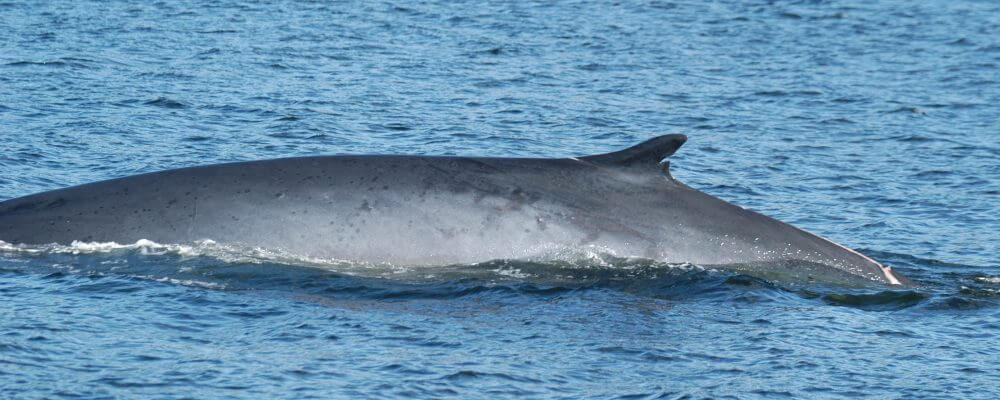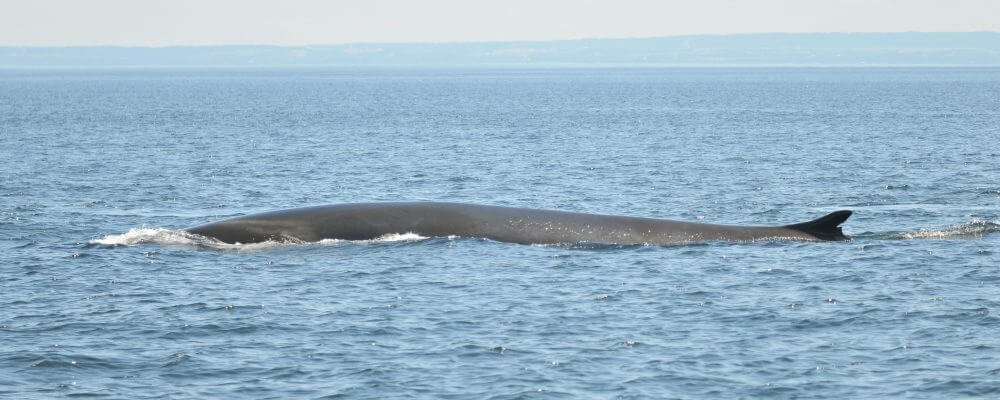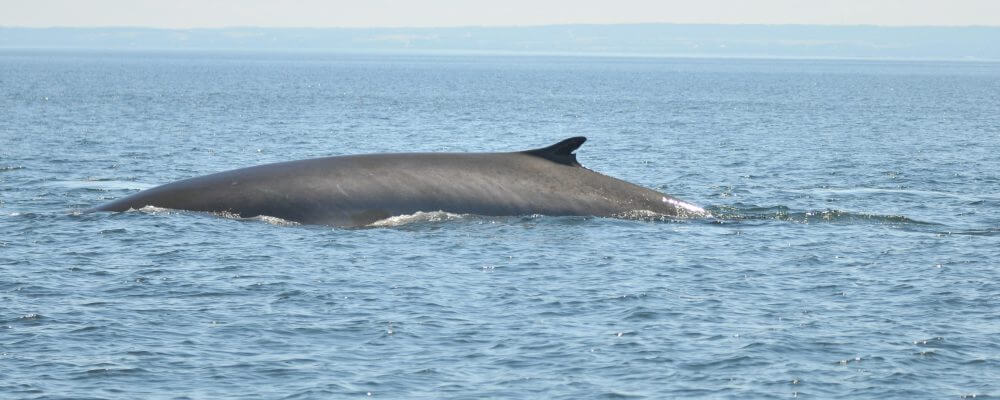Newkie Brown
Fin Whale


-
ID number
Bp068
-
Sex
Unknown
-
Year of birth
Unknown
-
Known Since
1991
Distinctive traits
Newkie Brown is recognizable at a glance. Its name comes from the bottle opener-shaped notch that decorates its dorsal fin—Newkie Brown is a brand of beer whose bottles are opened with a bottle opener. First appearing in 2003, the notch makes it easy to identify. Previously, this whale had very subtle markings that made it difficult to identify. To do so, researchers had to spend many hours matching different photos of the individual.
The chevron, clearly visible on the right side, is also a mark that allows for identification.
The scars on its peduncle, which appeared in 2004, are evidence of an accidental entanglement in fishing gear.
Finally, Newkie Brown is also distinguished by its rather small size.
Life history
Newkie Brown is often among the first fin whales to arrive in the Saguenay–St. Lawrence Marine Park in the spring. GREMM has photographed it regularly in the park area since 2011. It seems to greatly appreciate the estuary as a feeding ground. The proof: it has spent practically the entire season there almost every year since 1994!
In 2004, when researchers photographed Newkie Brown, new scars had appeared. After analysis, they concluded that the fin whale had recently become entangled in fishing gear.
Observations history in the Estuary
Years in which the animal was not observed Years in which the animal was observed
Latest news from the publications Portrait de baleines
Newkie Brown was present in the Marine Park this year at the end of June, having been identified by the GREMM team on the 24th. After a very brief visit, this fin whale might show up again in September, so keep your eyes peeled! Over the years, the team has noticed that its pattern of forays into the Marine Park is variable. Newkie Brown, generally one of the first fin whales of the season, spends two to six weeks in the Estuary. In 2008 and 2009, after a one-week stay in early summer, it disappeared and reappeared in September.
Its dorsal fin changed in 2003, taking the shape of a beer bottle opener. In 2004, Newkie Brown showed fresh injuries on its peduncle caused by entanglement in fishing gear; to this day it still bears a white scar.
In 1905, a hunting station under Norwegian control was established in the village of Sept-Îles and contributed to the vitality of the community. The factory employed some forty men from the region and 20 or so Scandinavians. They hunted blue and fin whales, harvesting some 70 to 85 a year.
In Canada, the conservation status of the North Atlantic fin whale is “Special Concern”. According to global data of the International Union for Conservation of Nature’s (IUCN) Red List of Threatened Species, the fin whale is “Endangered”. Between 1929 and 2007, i.e. three generations (fin whales having a life expectancy of nearly 100 years), its population fell by 70%.
After a 20-year hiatus, Iceland resumed commercial whaling of the fin whale in 2003. Since 2003 the country has harvested 280 individuals, selling the meat to Japan, which struggles to market it due to a lack of buyers. Iceland objects to the international moratorium on commercial hunting imposed by the International Whaling Commission in 1986.
One year after implementation of the moratorium, Japan, an IWC member, initiated a whaling program for “scientific purposes” (JARPA II), which calls for the capture of 50 fin whales a year in the Antarctic. The International Court of Justice has pressed Japan to end this hunt. The country has declared that it wishes to resume whaling in 2015 using new methods, reduced harvests, and targeting only minke whales.
In Greenland (a Danish territory), coastal communities, with a view to maintaining their traditional way of life, practise subsistence hunting with an annual quota of nine fin whales.
Like Captain Crochet, it is often among the first fin whales to arrive in the marine park in the spring. This is once again the case this year: a GREMM research assistant filmed Newkie Brown on May 7. This fin whale seems to enjoy the estuary as a feeding ground: it spends practically the entire season there, almost every year since 1994.
Before 2003, he was a rather difficult animal to recognize. That was before he acquired the characteristic notch in its dorsal fin, reminiscent of a bottle opener. In 2004, it arrived in the estuary with fresh wounds on its peduncle, evidence of a recent accidental entanglement in fishing gear. These marks are still visible in the form of scars.
The marks on the backs of whales tell the story of some of their misadventures. In the St. Lawrence, the extent of the problem of accidental catches for whales is unknown, but there are several anecdotes such as that of Newkie Brown. The case of the North Atlantic right whale, which frequents the Bay of Fundy and the US East Coast, is well documented. Between 1980 and 2004, at least 73% of individuals were entangled in fishing gear at least once, with up to six entanglements for a single animal.
Newkie Brown managed to free itself from fishing gear in 2004. What will happen to the female Captain Crochet, who has been entangled in a crab trap since May? She has been missing since June 13. A team is always ready to help her as soon as she is reported to Marine Mammal Emergency Response.
(1-877-722-5346).




